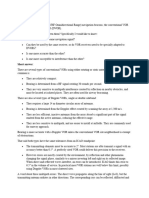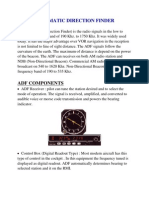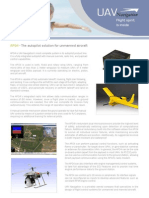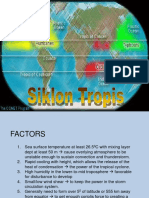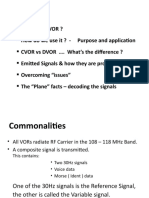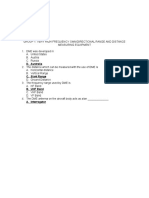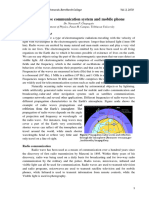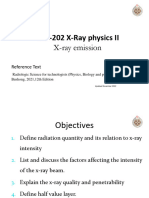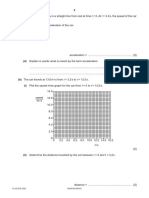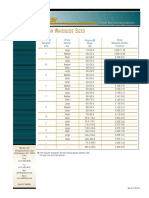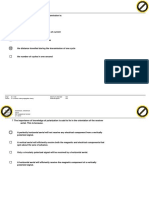100%(1)100% found this document useful (1 vote)
95 viewsRadio Theory: Air Waves in Aviation
Radio Theory: Air Waves in Aviation
Uploaded by
chand_basha_8The document discusses radio theory and its applications in aviation. It defines key terms like wavelength, frequency, and amplitude. It describes the different radio bands and their uses, including very low to ultra high frequencies. It covers properties of radio waves like reflection, refraction, and attenuation. It also discusses propagation methods and how the ionosphere affects low, medium, and high frequency transmissions. The document concludes by mentioning HF communications, antenna types, and data link systems used in aviation like VHF data link and satellite communications.
Copyright:
© All Rights Reserved
Available Formats
Download as PPT, PDF, TXT or read online from Scribd
Radio Theory: Air Waves in Aviation
Radio Theory: Air Waves in Aviation
Uploaded by
chand_basha_8100%(1)100% found this document useful (1 vote)
95 views16 pagesThe document discusses radio theory and its applications in aviation. It defines key terms like wavelength, frequency, and amplitude. It describes the different radio bands and their uses, including very low to ultra high frequencies. It covers properties of radio waves like reflection, refraction, and attenuation. It also discusses propagation methods and how the ionosphere affects low, medium, and high frequency transmissions. The document concludes by mentioning HF communications, antenna types, and data link systems used in aviation like VHF data link and satellite communications.
Original Description:
radio theory
Original Title
04 Radio Theory
Copyright
© © All Rights Reserved
Available Formats
PPT, PDF, TXT or read online from Scribd
Share this document
Did you find this document useful?
Is this content inappropriate?
The document discusses radio theory and its applications in aviation. It defines key terms like wavelength, frequency, and amplitude. It describes the different radio bands and their uses, including very low to ultra high frequencies. It covers properties of radio waves like reflection, refraction, and attenuation. It also discusses propagation methods and how the ionosphere affects low, medium, and high frequency transmissions. The document concludes by mentioning HF communications, antenna types, and data link systems used in aviation like VHF data link and satellite communications.
Copyright:
© All Rights Reserved
Available Formats
Download as PPT, PDF, TXT or read online from Scribd
Download as ppt, pdf, or txt
100%(1)100% found this document useful (1 vote)
95 views16 pagesRadio Theory: Air Waves in Aviation
Radio Theory: Air Waves in Aviation
Uploaded by
chand_basha_8The document discusses radio theory and its applications in aviation. It defines key terms like wavelength, frequency, and amplitude. It describes the different radio bands and their uses, including very low to ultra high frequencies. It covers properties of radio waves like reflection, refraction, and attenuation. It also discusses propagation methods and how the ionosphere affects low, medium, and high frequency transmissions. The document concludes by mentioning HF communications, antenna types, and data link systems used in aviation like VHF data link and satellite communications.
Copyright:
© All Rights Reserved
Available Formats
Download as PPT, PDF, TXT or read online from Scribd
Download as ppt, pdf, or txt
You are on page 1of 16
RADIO THEORY
Air Waves in Aviation
DEFINITIONS
• Radio transmission is an electromagnetic wave
with the same characteristics as light or heat.
• Wavelength is the linear measurement of the
wave.
• Cycle is the interval in which the wave rises and
falls between its crest and trough.
• Frequency is the number of cycles/second.
• Amplitude is the strength of the signal.
RADIO BANDS
• Low and Medium Frequency: Non
Directional Beacons and Marker Beacons
transmit signals on the LF/MF bands of
200 to 415KHz and 510 to 535KHz.
• High Frequency: used for air/ground
communication in remote northern areas
and on transoceanic flights. (longer range
than VHF) 2,500KHz to 30,000KHz
• Very High Frequency: the most common
frequency range in aviation, used for voice
communication, VOR, and ILS. 30MHz to
300MHz
• Ultra High Frequency: allocated for
military use, DME, and glide slope.
300MHz to 3,000MHZ
3 kHz to 30 kHz Very Low Frequencies (VLF)
30 kHz to 300 kHz Low Frequencies (LF)
300 kHz to 3,000 kHz Medium Frequencies (MF)
3,000 kHz to 30,000 kHz High Frequencies (HF)
30,000 kHz to 300,000 kHz Very High Frequencies (VHF)
300,000 kHz to 3,000,000 kHz Ultra High Frequencies (UHF)
PROPERTIES OF RADIO
WAVES
• Reflection: change of direction occurring at a
surface separating two different media.
• Refraction: bending of wave as it passes from
one medium to another.
• Diffraction: bending of wave as it passes
beside a non-conductive object.
• Attenuation: weakening of wave as it travels
through a medium.
PROPAGATION
• LF, MF, and HF transmit in two ways.
• Ground Waves: follow the surface of the earth
as an effect of diffraction and surface
attenuation.
• Sky Waves: travel into the atmosphere and are
reflected back to earth by the ionosphere.
• A skip zone exists between the points where
the ground waves end, and the sky waves strike
the earth. (erratic or non-existent signals)
• VHF waves are not affected by the same
propagation characteristics.
• These waves do not reflect off the ionosphere
but continue into space.
• They do not follow the curvature of the earth.
• This line-of-sight (space waves) characteristic
means reception is dependant on altitude.
1.23√AGL=range(nm)
ATMOSPHERIC CONDITIONS
• LF, MF, HF are affected by the changing height
of the ionosphere from day to night.
• At night sky waves travel are reflected by the
ionosphere which allows for reception at greater
distances.
• Sunspots and electromagnetic disturbances
affect the reflectivity of the ionosphere causing
signal fade out.
• Electrical fields associated with clouds (notably
thunderstorms) create precipitation static.
• VHF is virtually free from atmospheric and
precipitation static.
The ionosphere is a collection of ionized particles and electrons in the earths
atmosphere. It is responsible for reflecting LF, MF, and HF radio waves. The D-
layer which develops shortly after sunrise and disappears shortly after sunset
absorbs this radio energy minimizing the reflection of sky waves. When the D-
layer fades at night the radio waves are reflected back to earth as sky waves by
the E and F-layers.
HF COMMUNICATION
• Because of HF radios propagation
characteristics it is very useful for long range
communications.
• It is used in remote areas such as Northern
Canada and during transoceanic flights.
• The higher range of HF travels farther in the day
while the lower HF signals travel farther at night
due to the changing ionosphere.
– Sun up, frequency up
– Sun down, frequency down
ANTENNAS
• Radio antennas operate on the principle of
resonance: when a tuning fork is struck it
will vibrate at its natural frequency; when
two tuning forks are tuned to the same
frequency the first tuning fork will induce
vibration in the second.
• Radio antennas are tuned to the frequency
to be received.
• The ideal antenna length is one wavelength
long. That means a standard VHF antenna
would be 6-30 feet long. Antennas this length
are impractical, so sub-multiples are used.
• LF,MF,HF: long wave=long antenna (wire or
Pod)
• VHF: short wave=short antenna (mast)
• UHF: very short wave=very short antenna
(blade)
DATA LINK COMMUNICATIONS
• VHF data link: used for limited data transfer on
the ground such as ATIS, taxi instructions,
clearances, and graphical weather services. The
information is displayed on a display unit on the
flight deck.
• Satellite Communications (SATCOM): used
for communications in oceanic and remote
environments. Allows virtual global coverage
and high quality communications. Not subject to
typical radio reception problems.
You might also like
- Datasheet AIR 3218 2LB4HBp 2mDocument5 pagesDatasheet AIR 3218 2LB4HBp 2mMario Alvarez Garcia57% (7)
- Radar Theory For Area Approach Radar ControllersDocument38 pagesRadar Theory For Area Approach Radar ControllersMegheDhakaRodNo ratings yet
- VHF Omni-Directional Range (VOR)Document2 pagesVHF Omni-Directional Range (VOR)Shkelzen Goxhaj100% (1)
- AFMAN11-217 v.3Document209 pagesAFMAN11-217 v.3Alzheimer RachNo ratings yet
- NAR Radio Altimeter PDFDocument7 pagesNAR Radio Altimeter PDFdivya100% (1)
- Dvor 900 PDFDocument17 pagesDvor 900 PDFAgnelo Mapande100% (1)
- Thakur Institute of Aviation Technology: Synopsis: Non-Directional Beacon (NDB)Document5 pagesThakur Institute of Aviation Technology: Synopsis: Non-Directional Beacon (NDB)vinayNo ratings yet
- Visual Image Interpretation-TextDocument18 pagesVisual Image Interpretation-TextSaurabh Suman100% (5)
- 1a. Review Radio TheoryDocument46 pages1a. Review Radio TheoryRhonny AlbertoNo ratings yet
- RAN Radio Theory: By: Zuliana Ismail, 2010Document45 pagesRAN Radio Theory: By: Zuliana Ismail, 2010zuliana100% (1)
- Radio AidsDocument60 pagesRadio AidssagarikaNo ratings yet
- Cvor DvorDocument21 pagesCvor DvorMinh Trí Nguyễn (Minh Kio)No ratings yet
- Radio Navigation SlidesDocument42 pagesRadio Navigation Slidessegunajayi71No ratings yet
- Chapter 9 VORDocument26 pagesChapter 9 VORMarz ArcillasNo ratings yet
- ADFDocument14 pagesADFAfix RohmanNo ratings yet
- ADF (Automatic Direction Finder)Document6 pagesADF (Automatic Direction Finder)gregmNo ratings yet
- D M E DME: Istance Easuring QuipmentDocument17 pagesD M E DME: Istance Easuring QuipmentnsjnNo ratings yet
- Lab2 VOR PDFDocument10 pagesLab2 VOR PDFSafiraNo ratings yet
- Navigational AidsDocument69 pagesNavigational AidsChouaib Ben BoubakerNo ratings yet
- ADF1Document20 pagesADF1tercyNo ratings yet
- 8-VHF Omni-Directional Range (VOR)Document42 pages8-VHF Omni-Directional Range (VOR)Niyazi Cem GürsoyNo ratings yet
- Automated Landing Aids BY Fazeel Athar Saqib HussainDocument20 pagesAutomated Landing Aids BY Fazeel Athar Saqib HussainAir Cdre. Wajih Humayun Hashmi Assistant Professor-AviationNo ratings yet
- V.L.Singh'S RTR (A) Private Tutorials: Synopsis: Distance Measuring Equipment (Dme)Document5 pagesV.L.Singh'S RTR (A) Private Tutorials: Synopsis: Distance Measuring Equipment (Dme)vinay100% (1)
- Instrument Landing System Documantation1Document15 pagesInstrument Landing System Documantation1Chara GalaNo ratings yet
- AP04 Autopilot)Document3 pagesAP04 Autopilot)Mario EstigarribiaNo ratings yet
- Operational Notes On VHF Omni Range (VOR) : DisclaimerDocument23 pagesOperational Notes On VHF Omni Range (VOR) : DisclaimerIsmail MaielNo ratings yet
- 05 Tropical CycloneDocument91 pages05 Tropical CycloneElsye VeradikaNo ratings yet
- DVOR Training Course (Tambahan)Document41 pagesDVOR Training Course (Tambahan)dulli fitriantoNo ratings yet
- VHF Omni RangeDocument23 pagesVHF Omni RangeFazi Imi100% (1)
- IlsDocument18 pagesIlsFawad Afzal100% (1)
- ATPL Inst 5.1 PDFDocument4 pagesATPL Inst 5.1 PDFKoustubh VadalkarNo ratings yet
- Distance Measuring Equipment: This Article Is About Usage in Aviation. For Distance Measurement in GeneralDocument4 pagesDistance Measuring Equipment: This Article Is About Usage in Aviation. For Distance Measurement in GeneralAchrizNo ratings yet
- DME Lecture NotesDocument20 pagesDME Lecture NotesMuhammad HaziqNo ratings yet
- Lecture+7+ +Instrument+Landing+SystemDocument35 pagesLecture+7+ +Instrument+Landing+Systemsarithapriya100% (1)
- VorDocument7 pagesVorspypro05No ratings yet
- Automatic Direction Finder (ADF)Document17 pagesAutomatic Direction Finder (ADF)Re-ownRe-veNo ratings yet
- Question Combi - 082410Document43 pagesQuestion Combi - 082410JuhNo ratings yet
- Navigation I IDocument40 pagesNavigation I IMalou Ruiz DenolanNo ratings yet
- Distance Measuring EquipmentDocument13 pagesDistance Measuring EquipmentJb Basco100% (3)
- Navigation (Basic Course)Document356 pagesNavigation (Basic Course)Meda100% (2)
- Ils Concept PDFDocument166 pagesIls Concept PDFRAMESH RAGHU100% (2)
- Adf & NDBDocument20 pagesAdf & NDBNier JavierNo ratings yet
- Group1 - VOR and DME QuestionsDocument4 pagesGroup1 - VOR and DME QuestionsNichole ErikaNo ratings yet
- Thakur Institute of Aviation Technology: Synopsis: Distance Measuring Equipment (Dme)Document10 pagesThakur Institute of Aviation Technology: Synopsis: Distance Measuring Equipment (Dme)vinayNo ratings yet
- Metar - Taf - PirepDocument2 pagesMetar - Taf - PirepSantosh Raj KhanalNo ratings yet
- Navigatinal AidDocument29 pagesNavigatinal AidM.Tanseer Sibtain razaNo ratings yet
- DMEDocument27 pagesDMEZer0trix Gaming100% (2)
- International Standard Atmosphere (ISA)Document38 pagesInternational Standard Atmosphere (ISA)rahulsamyal100% (1)
- Automatic Direction Finder (ADF)Document33 pagesAutomatic Direction Finder (ADF)Anurekh Bhujade100% (1)
- CH #1 Basic Communication ConceptsDocument29 pagesCH #1 Basic Communication ConceptsShahid SohailNo ratings yet
- VHF Omnidirectional RangeDocument32 pagesVHF Omnidirectional RangePatricia Mae RectoNo ratings yet
- Chapter 13 DMEDocument16 pagesChapter 13 DMEneviaNo ratings yet
- Secondary Surveillance RadarDocument2 pagesSecondary Surveillance Radarspypro05No ratings yet
- RadNav Chp16 PBNDocument95 pagesRadNav Chp16 PBNNiyazi Cem Gürsoy100% (1)
- MARU 220 Manual Vol 1 PDFDocument180 pagesMARU 220 Manual Vol 1 PDFSasongko FightNo ratings yet
- Tm-Editor 25.04.2016 Seite 1 010-Air Law - LTM: 3.5.1 Annex 2: Typ: MC 1 Aviaexam22 9/29/2009 PKT.: 1.00Document199 pagesTm-Editor 25.04.2016 Seite 1 010-Air Law - LTM: 3.5.1 Annex 2: Typ: MC 1 Aviaexam22 9/29/2009 PKT.: 1.00Harika HakanNo ratings yet
- Radio Navigation Aids Presentation 2 Navaids RadarDocument54 pagesRadio Navigation Aids Presentation 2 Navaids RadarZulfiqar Mirani100% (2)
- Global Positioning Systems, Inertial Navigation, and IntegrationFrom EverandGlobal Positioning Systems, Inertial Navigation, and IntegrationNo ratings yet
- The SatNav Users Guide to Navigation and Mapping Using GPSFrom EverandThe SatNav Users Guide to Navigation and Mapping Using GPSRating: 1 out of 5 stars1/5 (2)
- Aviation Safety Inspector - The Comprehensive Guide: Vanguard ProfessionalsFrom EverandAviation Safety Inspector - The Comprehensive Guide: Vanguard ProfessionalsNo ratings yet
- Radio Theory PPDocument16 pagesRadio Theory PPPeter ChanceNo ratings yet
- Compendium TACTICAL RADIO Aug Sept 2012 PDFDocument32 pagesCompendium TACTICAL RADIO Aug Sept 2012 PDFchand_basha_8100% (3)
- 0580 - m16 - QP - 22-Past Apers - IGSCDocument12 pages0580 - m16 - QP - 22-Past Apers - IGSCchand_basha_80% (1)
- Section 13Document67 pagesSection 13chand_basha_8No ratings yet
- Star Safire380Document2 pagesStar Safire380chand_basha_8No ratings yet
- Nortel Meridian 81C With AudioCodes Mediant 1000 & 2000 Using T1 QSIGDocument44 pagesNortel Meridian 81C With AudioCodes Mediant 1000 & 2000 Using T1 QSIGchand_basha_8No ratings yet
- Odes SeyDocument4 pagesOdes Seyronaldmapfumo1200No ratings yet
- Pes Phy Unit 1Document181 pagesPes Phy Unit 1themostbeautifulmoment01No ratings yet
- MCQs in Fiber Optics Communications Part IV - PinoyBIX - Engineering Review PDFDocument11 pagesMCQs in Fiber Optics Communications Part IV - PinoyBIX - Engineering Review PDFSumeet BhardwajNo ratings yet
- Sobreeexploração Dos Solos: Daniel Macave Nº7 Diana Mendonça Nº9 Francisco Moura Nº10Document29 pagesSobreeexploração Dos Solos: Daniel Macave Nº7 Diana Mendonça Nº9 Francisco Moura Nº10rutinha chanNo ratings yet
- MV-101 Solar Blind UV DatasheetDocument5 pagesMV-101 Solar Blind UV DatasheetAries dNo ratings yet
- X Ray EmissionDocument66 pagesX Ray EmissiondanasardyNo ratings yet
- Module 4 Electrons Photons Waves DefitionsDocument5 pagesModule 4 Electrons Photons Waves DefitionsAbir MohammedNo ratings yet
- Lampu Operasi LED Purelit OL9500 (Short Version)Document2 pagesLampu Operasi LED Purelit OL9500 (Short Version)Gandhi OnoNo ratings yet
- (461513) 1.4 BGE 1 - Electromagnetic Spectrum Summary NotesDocument7 pages(461513) 1.4 BGE 1 - Electromagnetic Spectrum Summary NotesAarti PrajapatiNo ratings yet
- Svetilki PDFDocument372 pagesSvetilki PDFDarko JakovleskiNo ratings yet
- IGCSE Physics 0625 42 Paper 4 Feb Mar 2023Document15 pagesIGCSE Physics 0625 42 Paper 4 Feb Mar 2023Oorjit SethiNo ratings yet
- Dbal A3Document12 pagesDbal A3Francisco ArancibiaNo ratings yet
- LaserBasedExplosiveDet TN 0912 508Document2 pagesLaserBasedExplosiveDet TN 0912 508Mohammed MalikNo ratings yet
- Class 2Document10 pagesClass 2Shahadat SabbirNo ratings yet
- Circular Waveguide DimensionsDocument1 pageCircular Waveguide DimensionsRaktim GuhaNo ratings yet
- Bookstore Presentation From The Secret Language of Color AuthorsDocument27 pagesBookstore Presentation From The Secret Language of Color AuthorsBlack Dog & Leventhal67% (3)
- Nav 3Document100 pagesNav 3trevor t.kNo ratings yet
- Lighting Building Service SystemsDocument5 pagesLighting Building Service SystemsPrincess Morales TyNo ratings yet
- CWNA Chapter3Document45 pagesCWNA Chapter3SerNo ratings yet
- Engineering PhysicsDocument31 pagesEngineering PhysicsJoan VincentNo ratings yet
- In ScienceDocument2 pagesIn Sciencemansi bavliyaNo ratings yet
- ZTE Cable ColorDocument2 pagesZTE Cable ColorAhmed IsmailNo ratings yet
- Read The Words. Colour The Picture Using Code. 1 Green 2 Blue 3 Red 4 Yellow 5 BrownDocument4 pagesRead The Words. Colour The Picture Using Code. 1 Green 2 Blue 3 Red 4 Yellow 5 BrownAtif AzyzyNo ratings yet
- MCQ CompilediiDocument62 pagesMCQ CompilediiMerin0% (1)
- Erco Whitepaper Green Wall 01 2022 enDocument15 pagesErco Whitepaper Green Wall 01 2022 enJozo BozoNo ratings yet
- E4nE6-Interference and Diffraction of Light-Atomic Spectra-Rev1Document14 pagesE4nE6-Interference and Diffraction of Light-Atomic Spectra-Rev1Lee Kar HuoNo ratings yet
- Q4 - Las 8Document2 pagesQ4 - Las 8JESSA SUMAYANGNo ratings yet
- Football Stadium LightingDocument6 pagesFootball Stadium LightingMurali KannanNo ratings yet











